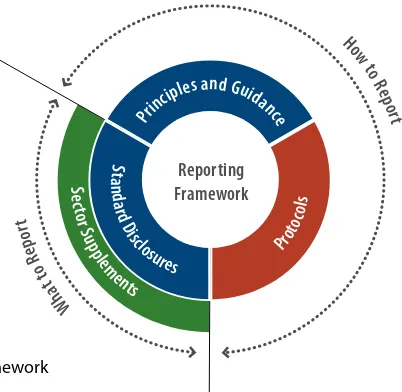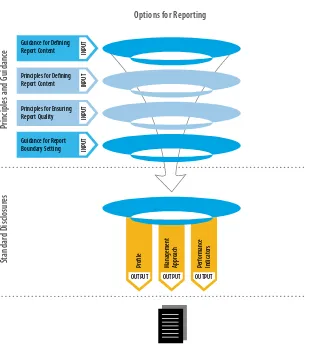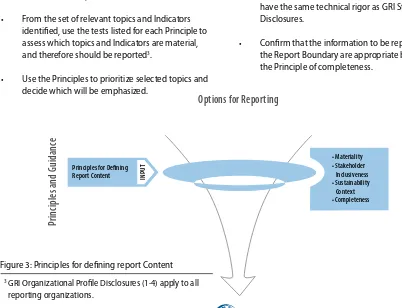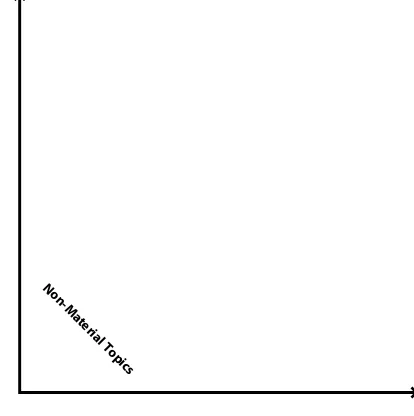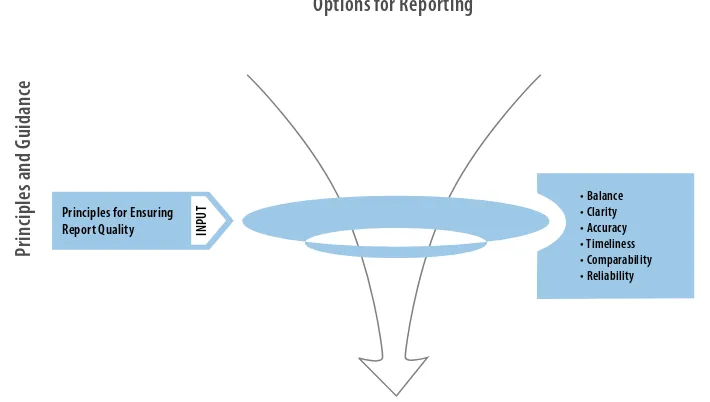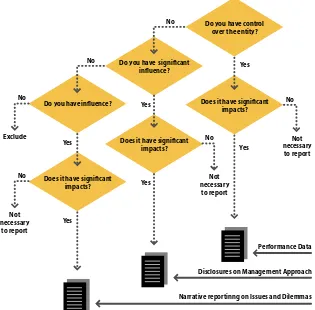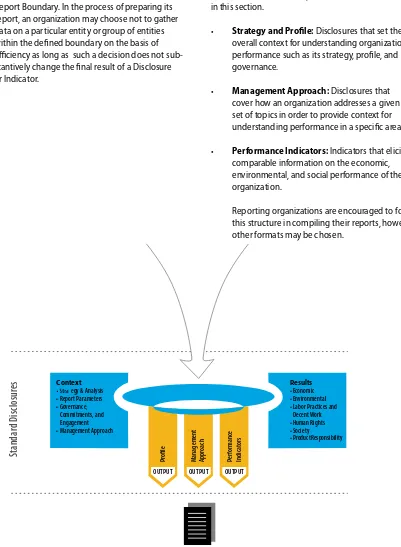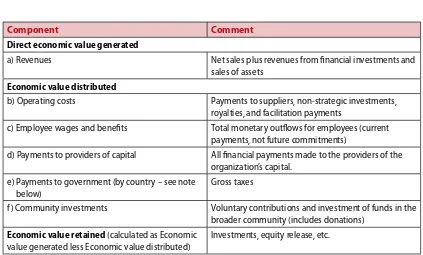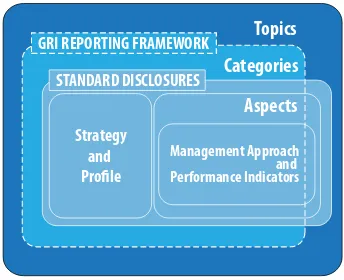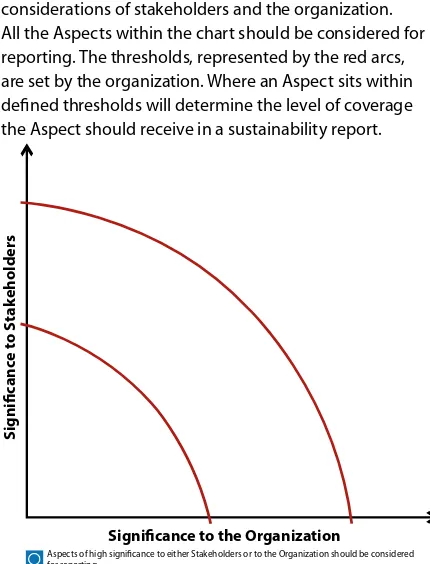Sustainability Reporting Guidelines
RG
1
Sustainability Reporting Guidelines
RG
Version 3.1
Table of Contents
Preface
Sustainable Development and the Transparency Imperative
Introduction
Overview of Sustainability Reporting
The Purpose of a Sustainability Report 3 Orientation to the GRI Reporting Framework 3 Orientation to the GRI Guidelines 4 Applying the Guidelines 5
Part 1
Deining Report Content, Quality, and Boundary
Guidance for Deining Report Content 7 Principles for Deining Report Content 8 Principles for Deining Report Quality 13 Guidance for Report Boundary Setting 17
Part 2
Standard Disclosures
Strategy and Proile 20
1. Strategy and Analysis 20 2. Organizational Proile 21 3. Report Parameters 21 4. Governance, Commitments,
and Engagement 22 5. Management Approach and
Performance Indicators 24
Economic 25
Environmental 27
Social:
Labor Practices and Decent Work 30
Human Rights 32
Society 36
Product Responsibility 39
General Reporting Notes
Data Gathering 40
Report Form and Frequency 40
Assurance 41
2
Sustainability Reporting Guidelines
RG
© 2000-2011 GRI
Preface
Sustainable Development and the
Transparency Imperative
The goal of sustainable development is to “meet the needs of the present without compromising the ability of future generations to meet their own needs.”1 As
key forces in society, organizations of all kinds have an important role to play in achieving this goal.
Yet in this era of unprecedented economic growth, achieving this goal can seem more of an aspiration than a reality. As economies globalize, new opportunities to generate prosperity and quality of life are arising though trade, knowledge-sharing, and access to technology. However, these opportunities are not always available for an ever-increasing human population, and are accompanied by new risks to the stability of the environment. Statistics demonstrating positive improvements in the lives of many people around the world are counter-balanced by alarming information about the state of the environment and the continuing burden of poverty and hunger on millions of people. This contrast creates one of the most pressing dilemmas for the 21st century.
One of the key challenges of sustainable development is that it demands new and innovative choices and ways of thinking. While developments in knowledge and technology are contributing to economic development, they also have the potential to help resolve the risks and threats to the sustainability of our social relations, environment, and economies. New knowledge and innovations in technology, management, and public policy are challenging organizations to make new choices in the way their operations, products, services, and activities impact the earth, people, and economies.
The urgency and magnitude of the risks and threats to our collective sustainability, alongside increasing choice and opportunities, will make transparency about economic, environmental, and social impacts a fundamental component in efective stakeholder relations, investment decisions, and other market relations. To support this expectation, and to communicate clearly and openly about sustainability, a globally shared framework of concepts, consistent language, and metrics is required. It is the Global Reporting Initiative’s (GRI) mission to fulil this need by providing a trusted and credible framework for sustainability reporting that can be used by organizations of any size, sector, or location.
Transparency about the sustainability of organizational activities is of interest to a diverse range of stakeholders, including business, labor, non-governmental
organizations, investors, accountancy, and others. This is why GRI has relied on the collaboration of a large network of experts from all of these stakeholder groups in consensus-seeking consultations. These consultations, together with practical experience, have continuously improved the Reporting Framework since GRI’s founding in 1997. This multi-stakeholder approach to learning has given the Reporting Framework the widespread credibility it enjoys with a range of stakeholder groups.
1 World Commission on Environment and Development. Our
3
Sustainability Reporting Guidelines
RG
Version 3.1
Overview of Sustainability
Reporting
The Purpose of a Sustainability Report
Sustainability reporting is the practice of measuring, disclosing, and being accountable to internal and external stakeholders for organizational performance towards the goal of sustainable development. ‘Sustainability reporting’ is a broad term considered synonymous with others used to describe reporting on economic, environmental, and social impacts (e.g., triple bottom line, corporate responsibility reporting, etc.).
A sustainability report should provide a balanced and reasonable representation of the sustainability performance of a reporting organization – including both positive and negative contributions.
Sustainability reports based on the GRI Reporting Framework disclose outcomes and results that occurred within the reporting period in the context of the organization’s commitments, strategy, and management approach. Reports can be used for the following purposes, among others:
• Benchmarking and assessing sustainability performance with respect to laws, norms, codes, performance standards, and voluntary initiatives;
• Demonstrating how the organization inluences and is inluenced by expectations about sustainable development; and
• Comparing performance within an organization and between diferent organizations over time.
Orientation to the GRI Reporting
Framework
All GRI Reporting Framework documents are developed using a process that seeks consensus through dialogue between stakeholders from business, the investor community, labor, civil society, accounting, academia, and others. All Reporting Framework documents are subject to testing and continuous improvement.
The GRI Reporting Framework is intended to serve as a generally accepted framework for reporting on an organization’s economic, environmental, and social performance. It is designed for use by organizations of any size, sector, or location. It takes into account the practical considerations faced by a diverse range of organizations – from small enterprises to those with extensive and geographically dispersed operations. The GRI Reporting Framework contains general and sector-speciic content that has been agreed by a wide range of stakeholders around the world to be generally applicable for reporting an organization’s sustainability performance.
The Sustainability Reporting Guidelines (the Guidelines) consist of Principles for deining report content and ensuring the quality of reported
[image:5.595.195.396.557.753.2]information. It also includes Standard Disclosures made up of Performance Indicators and other disclosure items, as well as guidance on speciic technical topics in reporting.
Figure 1: The GRI Reporting Framework
Se ctor S up plem ents W ha t t o Re po rt How to R
ep ort Prot ocol s St an dard D isc losures Princ
iples and Guidan
ce
4
Sustainability Reporting Guidelines
RG
© 2000-2011 GRI
Indicator Protocols exist for each of the Performance Indicators contained in the Guidelines. These Protocols provide deinitions, compilation guidance, and other information to assist report preparers and to ensure consistency in the interpretation of the Performance Indicators. Users of the Guidelines should also use the Indicator Protocols.
Sector Supplements complement the Guidelines with interpretations and guidance on how to apply the Guidelines in a given sector, and include sector-speciic Performance Indicators. Applicable Sector Supplements should be used in addition to the Guidelines rather than in place of the Guidelines.
Technical Protocols are created to provide guidance on issues in reporting, such as setting the report boundary. They are designed to be used in conjunction with the Guidelines and Sector Supplements and cover issues that face most organizations during the reporting process.
Orientation to the GRI Guidelines
The Sustainability Reporting Guidelines consist of Reporting Principles, Reporting Guidance, and Standard Disclosures (including Performance Indicators). These elements are considered to be of equal in weight and importance.
Part 1 – Reporting Principles and Guidance
[image:6.595.134.443.400.747.2]Three main elements of the reporting process are described in Part 1. To help determine what to report on, this section covers the Reporting Principles of materiality, stakeholder inclusiveness, sustainability context, and completeness, along with a brief set of tests for each Principle. Application of these Principles with the Standard Disclosures determines the topics and Indicators to be reported. This is followed by Principles of balance, comparability, accuracy, timeliness, reliability, and clarity, along with tests that can be used to help achieve the appropriate quality of the reported information. This section concludes with guidance for reporting organizations on how to deine the range of entities represented by the report (also called the ‘Report Boundary’).
Figure 2: Overview of the GRI Guidelines
OUTPUT OUTPUT OUTPUT
Pe
rf
ormance
Indic
at
ors
Pr
ofile
Management Appr
oach
INPUT
INPUT
INPUT
INPUT
Focused Sustainability Report
Standar
d D
isclosur
es
Principles and Guidance
Options for Reporting
Guidance for Defining Report Content
Principles for Defining Report Content
Principles for Ensuring Report Quality
5
Sustainability Reporting Guidelines
RG
Version 3.1 Part 2 – Standard Disclosures
Part 2 contains the Standard Disclosures that should be included in sustainability reports. The Guidelines identify information that is relevant and material to most organizations and of interest to most stakeholders for reporting the three types of Standard Disclosures:
• Strategy and Proile: Disclosures that set the overall context for understanding organizational performance such as its strategy, proile, and governance.
• Management Approach: Disclosures that cover how an organization addresses a given set of topics in order to provide context for understanding performance in a speciic area.
• Performance Indicators: Indicators that elicit comparable information on the economic, environmental, and social performance of the organization.
Applying the Guidelines
Getting Started
All organizations (private, public, or non-proit) are encouraged to report against the Guidelines whether they are beginners or experienced reporters, and regardless of their size, sector, or location. Reporting can take various forms, including web or print, stand alone or combined with annual or inancial reports.
The irst step is to determine report content. Guidance for this is provided in Part 1. Some organizations may choose to introduce reporting against the full GRI Reporting Framework from the outset, while others may want to start with the most feasible and practical topics irst and phase in reporting on other topics over time. All reporting organizations should describe the scope of their reporting and are encouraged to indicate their plans for expanding their reporting over time.
GRI Application Levels
Upon inalization of their report, preparers should declare the level to which they have applied the GRI Reporting Framework via the “GRI Application Levels” system. This system aims to provide:
• Report readers with clarity about the extent to which the GRI Guidelines and other Reporting Framework elements have been applied in the preparation of a report.
• Report preparers with a vision or path for incrementally expanding application of the GRI Reporting Framework over time.
Declaring an Application Level results in a clear communi-cation about which elements of the GRI Reporting Frame-work have been applied in the preparation of a report. To meet the needs of new beginners, advanced reporters, and those somewhere in between, there are three levels in the system. They are titled C, B, and A, The reporting criteria found in each level relects an increasing application or coverage of the GRI Reporting Framework. An organization can self-declare a “plus” (+) at each level (ex., C+, B+, A+) if they have utilized external assurance.2
An organization self-declares a reporting level based on its own assessment of its report content against the criteria in the GRI Application Levels.
2 See the assurance section under General Reporting Notes
6
Sustainability Reporting Guidelines
RG
© 2000-2011 GRI
In addition to the self declaration, reporting organizations can choose one or both of the following options:
• Have an assurance provider ofer an opinion on the
self-declaration.
• Request that the GRI check the self-declaration.
For more information on Application Levels, and the complete criteria, see the GRI Applications Level information pack available as an insert to this document, or found online at www.globalreporting.org.
Request for notiication of use
Organizations that have used the Guidelines and/or other elements of the GRI Reporting Framework as the basis for their report are requested to notify the Global Reporting Initiative upon its release. While notifying GRI, organizations can choose any or all of the following options:
• Simply notify the GRI of the report and provide
hard and/or soft copy
• Register their report in GRI’s online database of reports • Request GRI check their self-declared Application
Level.
Maximizing Report Value
Sustainability reporting is a living process and tool, and does not begin or end with a printed or online publication. Reporting should it into a broader process for setting organizational strategy, implementing action plans, and assessing outcomes. Reporting enables a robust assessment of the organization’s performance, and can support continuous improvement in performance over time. It also serves as a tool for engaging with stakeholders and securing useful input to organizational processes.
Part 1: Deining Report Content, Quality,
and Boundary
This section provides Reporting Principles and Reporting Guidance regarding deining report content, ensuring the quality of reported information, and setting the Report Boundary.
Reporting Guidance describes actions that can be taken, or options that the reporting organization can consider when making decisions on what to report on, and generally helps interpret or govern the use of the GRI Reporting Framework. Guidance is provided for deining report content and setting report Boundary.
Reporting Principles describe the outcomes a report should achieve and guide decisions throughout the reporting process, such as selecting which topics and Indicators to report on and how to report on them. Each of the Principles consists of a deinition, an explanation, and a set of tests for the reporting organization to assess its use of the Principles. The tests are intended to serve as tools for self-diagnosis, but not as speciic disclosures to report against. Tests can, however, serve as a reference for explaining decisions about the application of the Principles
Together, the Principles are intended to help achieve transparency – a value and a goal that underlies all aspects of sustainability reporting. Transparency can be deined as the complete disclosure of information on the topics and Indicators required to relect impacts and enable stakeholders to make decisions, and the processes, procedures, and assumptions used to prepare those disclosures. The Principles themselves are organized into two groups:
• Principles for determining the topics and Indicators
on which the organization should report; and
• Principles for ensuring the quality and appropriate
presentation of reported information.
7
Sustainability Reporting Guidelines
RG
Version 3.1 • Materiality
• Stakeholder Inclusiveness • Sustainability Context • Completeness
INPUT
Principles and Gu
idance
Options for Reporting
Principles for Defining Report Content
1.1 Deining Report Content
In order to ensure a balanced and reasonable presentation of the organization’s performance, a determination must be made about what content the report should cover. This determination should be made by considering both the organization’s purpose and experience, and the reasonable expectations and interests of the organization’s stakeholders. Both are important reference points when deciding what to include in the report.
Reporting Guidance for Deining Content
The following approach governs the use of the GRI Reporting Framework in preparing sustainability reports. More detailed guidance on deining content can be found in the Technical Protocol – Applying the Report Content Principles.
• Identify the topics and related Indicators that are
relevant, and therefore might be appropriate to report, by undergoing an iterative process using the Principles of materiality, stakeholder inclusiveness,
sustainability context, and guidance on setting the Report Boundary.
• When identifying topics, consider the relevance of
all Indicator Aspects identiied in the GRI Guidelines and applicable Sector Supplements. Also consider other topics, if any, that are relevant to report.
• From the set of relevant topics and Indicators
identiied, use the tests listed for each Principle to assess which topics and Indicators are material, and therefore should be reported3.
• Use the Principles to prioritize selected topics and
decide which will be emphasized.
• The speciic methods or processes used for
assessing materiality should:
• Difer for, and can be deined by, each
organization;
• Always take into account the guidance and
tests found in the GRI Reporting Principles; and
• Be disclosed.
In applying this approach:
• Diferentiate between Core and Additional
Indicators. All Indicators have been developed through GRI’s multi-stakeholder processes, and those designated as Core are generally applicable Indicators and are assumed to be material for most organizations. An organization should report on these unless they are deemed not material on the basis of the Reporting Principles. Additional Indicators may also be determined to be material.
• The Indicators in inal versions of Sector
Supplements are considered to be Core Indicators, and should be applied using the same approach as the Core Indicators found in the Guidelines.
• All other information (e.g., company speciic
Indicators) included in the report should be subject to the same Reporting Principles and have the same technical rigor as GRI Standard Disclosures.
• Conirm that the information to be reported and
[image:9.595.73.475.476.784.2]the Report Boundary are appropriate by applying the Principle of completeness.
Figure 3: Principles for deining report Content
8
Sustainability Reporting Guidelines
RG
© 2000-2011 GRI
Reporting Principles for Deining Content
Each of the Reporting Principles consists of a deinition, an explanation, and a set of tests to guide the use of the Principles. The tests are intended to serve as tools for self-diagnosis, but not as speciic Disclosure items to report against. The Principles should be used together with the guidance on deining content.
MateRiality
Deinition: The information in a report should cover topics and Indicators that:
• relect the organization’s signiicant economic,
environmental, and social impacts or that
• would substantively inluence the assessments and
decisions of stakeholders.
Explanation: Organizations are faced with a wide range of topics on which it could report. Relevant topics and Indicators are those that may reasonably be considered important for relecting the organization’s economic, environmental, and social impacts, or inluencing the decisions of stakeholders, and, therefore, potentially merit inclusion in the report. Materiality is the threshold at which topics or Indicators become suiciently important that they should be reported. Beyond this threshold, not all material topics will be of equal importance and the emphasis within a report should relect the relative priority of these material topics and Indicators.
In inancial reporting, materiality is commonly thought of as a threshold for inluencing the economic decisions of those using an organization’s inancial statements, investors in particular. The concept of a threshold is also important in sustainability reporting, but it is concerned with a wider range of impacts and stakeholders. Materiality for sustainability reporting is not limited only to those sustainability topics that have a signiicant inancial impact on the organization. Determining materiality for a sustainability report also includes considering economic, environmental, and social impacts that cross a threshold in afecting the ability to meet the needs of the present without compromising the needs of future generations.4 These material topics
will often have a signiicant inancial impact in the near-term or long-near-term on an organization. They will therefore also be relevant for stakeholders who focus strictly on the inancial condition of an organization.
A combination of internal and external factors should be used to determine whether information is material, including factors such as the organization’s overall mission and competitive strategy, concerns expressed directly by stakeholders, broader social expectations, and the organization’s inluence on upstream (e.g., supply chain) and downstream (e.g., customers) entities. Assessments of materiality should also take into account the basic expectations expressed in the international standards and agreements with which the organization is expected to comply.
These internal and external factors should be considered when evaluating the importance of information for relecting signiicant economic, environmental, and social impacts, or stakeholder decision making.5 A range
of established methodologies can be used to assess the signiicance of impacts. In general, ‘signiicant impacts’ refer to those that are a subject of established concern for expert communities, or that have been identiied using established tools such as impact assessment methodologies or life cycle assessments. Impacts that are considered important enough to require active management or engagement by the organization can likely be considered to be signiicant.
Significance of Economic, Environmental, and Social Impacts
Influenc
e on Stak
eholder Assessmen
ts and Decisions
Material Topics
Non-Ma
terial Topics
Low Rela tive Repor
[image:10.595.315.522.482.690.2]ting P riority High
Figure 4: Deining Materiality
9
Sustainability Reporting Guidelines
RG
Version 3.1
The report should emphasize information on performance regarding the most material topics. Other relevant topics can be included, but should be given less prominence in the report. The process by which the relative priority of topics was determined should be explained.
In addition to guiding the selection of topics to report, the Materiality Principle also applies to the use of Performance Indicators. When disclosing performance data, there are varying degrees of comprehensiveness and detail that could be provided in a report. In some cases, GRI guidance exists on the level of detail generally considered appropriate for a speciic Indicator. Overall, decisions on how to report data should be guided by the importance of the information for assessing the performance of the organization, and facilitating appropriate comparisons.
Reporting on material topics may involve disclosing information used by external stakeholders that difers from the information used internally for day-to-day management purposes. However, such information does indeed belong in a report, where it can inform assessments or decision-making by stakeholders, or support engagement with stakeholders that can result in actions that would signiicantly inluence performance or address key topics of stakeholder concern.
Tests
In deining material topics, take into account the following:
R Reasonably estimable sustainability impacts, risks, or opportunities (e.g., global warming, HIV-AIDS, poverty) identiied through sound investigation by people with recognized expertise, or by expert bodies with recognized credentials in the ield.
Signiicance to Stakeholders, including:
R Main sustainability interests/topics and Indicators raised by stakeholders (e.g., vulnerable groups within local communities, civil society).
R The main topics and future challenges for the sector reported by peers and competitors.
R Relevant laws, regulations, international agreements, or voluntary agreements with strategic signiicance to the organization and its stakeholders.
Signiicance to the Organization, including:
R Key organizational values, policies, strategies, operational management systems, goals, and targets.
R The interests/expectations of stakeholders speciically invested in the success of the organi-zation (e.g., employees, shareholders, and suppliers).
R Signiicant risks to the organization.
R Critical factors for enabling organizational success.
R The core competencies of the organization and the manner in which they can or could contribute to sustainable development.
Prioritizing
10
Sustainability Reporting Guidelines
RG
© 2000-2011 GRI
StakeholdeR incluSiveneSS
Deinition: The reporting organization should identify its stakeholders and explain in the report how it has responded to their reasonable expectations and interests.
Explanation: Stakeholders are deined as entities or individuals that can reasonably be expected to be signiicantly afected by the organization’s activities, products, and/or services; and whose actions can reasonably be expected to afect the ability of the organization to successfully implement its strategies and achieve its objectives. This includes entities or individuals whose rights under law or international conventions provide them with legitimate claims vis-à-vis the organization.
Stakeholders can include those who are invested in the organization (e.g., employees, shareholders, suppliers) as well as those who have other relationships to the organization (e.g., vulnerable groups within local communities, civil society).
The reasonable expectations and interests of stakeholders are a key reference point for many decisions in the preparation of a report, such as the scope, boundary, application of Indicators, and assurance approach. However, not all of an organization’s stakeholders will use the report. This presents challenges in balancing the speciic interests/ expectations of stakeholders who can reasonably be expected to use the report with broader expectations of accountability to all stakeholders.
For some decisions, such as the report scope or boundary of a report, the reasonable expectations and interests of a wide range of stakeholder will need to be considered. There may be, for example, stakeholders who are unable to articulate their views on a report and whose concerns are presented by proxies. There may also be stakeholders who choose not to express views on reports because they rely on diferent means of communication and engagement. The reasonable expectations and interests of these stakeholders should still be acknowledged in decisions about the content of the report. However, other decisions, such as the level of detail required to be useful to stakeholders, or expectations of diferent stakeholders about what is required to achieve clarity, may require greater emphasis on those who can reasonably be expected to use the report. It is important to document the processes and approach taken in making these decisions.
Stakeholder engagement processes can serve as tools for understanding the reasonable expectations and interests of stakeholders. Organizations typically initiate diferent types of stakeholder engagement as part of their regular activities, which can provide useful inputs for decisions on reporting. These may include, for example, stakeholder engagement for the purpose of compliance with internationally-agreed standards, or informing ongoing organizational/ business processes. In addition, stakeholder engagement may also be implemented speciically to inform the report preparation process. Organizations can also use other means such as the media, the scientiic community, or collaborative activities with peers and stakeholders. These means can help the organization better understand stakeholders’ reasonable expectations and interests.
For a report to be assurable, the process of stakeholder engagement should be documented. When stakeholder engagement processes are used for reporting purposes, they should be based on systematic or generally-accepted approaches, methodologies, or principles. The overall approach should be suiciently efective to ensure that stakeholders’ information needs are properly understood. The reporting organization should document its approach for deining which stakeholders it engaged with, how and when it engaged with them, and how engagement has inluenced the report content and the organization’s sustainability activities. These processes should be capable of identifying direct input from stakeholders as well as legitimately established societal expectations. An organization may encounter conlicting views or difering expectations among its stakeholders, and will need to be able to explain how it balanced these in reaching its reporting decisions.
11
Sustainability Reporting Guidelines
RG
Version 3.1
Tests:
R The organization can describe the stakeholders to whom it considers itself accountable.
R The report content draws upon the outcomes of stakeholder engagement processes used by the organization in its ongoing activities, and as required by the legal and institutional framework in which it operates.
R The report content draws upon the outcomes of any stakeholder engagement processes undertaken speciically for the report.
R The stakeholder engagement processes that inform decisions about the report are consistent with the scope and boundary of the report.
SuStainability context
Deinition: The report should present the organization’s performance in the wider context of sustainability.
Explanation: Information on performance should be placed in context. The underlying question of sustainability reporting is how an organization contributes, or aims to contribute in the future, to the improvement or deterioration of economic, environmental, and social conditions, developments, and trends at the local, regional, or global level. Reporting only on trends in individual performance (or the eiciency of the organization) will fail to respond to this underlying question. Reports should therefore seek to present performance in relation to broader concepts of sustainability. This will involve discussing the performance of the organization in the context of the limits and demands placed on environmental or social resources at the sectoral, local, regional, or global level. For example, this could mean that in addition to reporting on trends in eco-eiciency, an organization might also present its absolute pollution loading in relation to the capacity of the regional ecosystem to absorb the pollutant.
This concept is often most clearly articulated in the environmental arena in terms of global limits on resource use and pollution levels. However, it can also be relevant with respect to social and economic objectives such as national or international socio-economic and sustainable development goals. For example, an organization could report on employee wages and social beneit levels in relation to nation-wide minimum and median income levels, and the capacity of social safety nets to absorb those in poverty or those living close to the poverty line. Organizations operating in a diverse range of locations, sizes, and sectors will need to consider how to best frame their overall organizational performance in the broader context of sustainability. This may require distinguishing between topics or factors that drive global impacts (such as climate change) and those that have more regional or local impacts (such as community development). When reporting on topics that have positive or negative local impacts, it is important to provide insight into how the organization afects communities in diferent locations. Similarly, distinctions might need to be made between trends or patterns of impacts across the range of operations versus contextualizing performance location by location.
12
Sustainability Reporting Guidelines
RG
© 2000-2011 GRI
performance. The relationship between sustainability and organizational strategy should be made clear, as should the context within which performance is reported.
Tests:
R The organization presents its understanding of sustainable development and draws on objective and available information as well as measures of sustainable development for the topics covered in the report.
R The organization presents its performance with reference to broader sustainable development conditions and goals, as relected in recognized sectoral, local, regional, and/or global publications.
R The organization presents its performance in a manner that attempts to communicate the magnitude of its impact and contribution in appropriate geographical contexts.
R The report describes how sustainability topics relate to long-term organizational strategy, risks, and opportunities, including supply-chain topics.
coMpleteneSS
Deinition: Coverage of the material topics and Indicators and deinition of the report boundary should be suicient to relect signiicant economic, environmental, and social impacts and enable stakeholders to assess the reporting organization’s performance in the reporting period.
Explanation: Completeness primarily encompasses the dimensions of scope, boundary, and time. The concept of completeness can also be used to refer to practices in information collection (for example, ensuring that compiled data includes results from all sites within the Report Boundary) and whether the presentation of information is reasonable and appropriate. These topics are related to report quality, and are addressed in greater detail under the Principles of accuracy and balance later in Part 1.
Scope refers to the range of sustainability topics covered in a report. The sum of the topics and Indicators reported should be suicient to relect signiicant economic, environmental, and social impacts. It should also enable stakeholders to assess the organization’s performance. In determining whether the information in the report is suicient, the organization should consider both the results of stakeholder engagement processes and broad-based societal expectations that may not have surfaced directly through stakeholder engagement processes.
‘Boundary’ refers to the range of entities (e.g.,
subsidiaries, joint ventures, sub-contractors, etc.) whose performance is represented by the report. In setting the boundary for its report, an organization must consider the range of entities over which it exercises control (often referred to as the ‘organizational boundary’, and usually linked to deinitions used in inancial reporting) and over which it exercises inluence (often called the ‘operational boundary’). In assessing inluence, the organization will need to consider its ability to inluence entities upstream (e.g., in its supply chain) as well as entities downstream (e.g., distributors and users of its products and services). The boundary may vary based on the speciic Aspect or type of information being reported.
13
Sustainability Reporting Guidelines
RG
Version 3.1
a signiicant and reasonably foreseeable cumulative efect that may become unavoidable or irreversible in the longer term (e.g., bio-accumulative or persistent pollutants). In making estimates of future impacts (both positive and negative), the reported information should be based on well-reasoned estimates that relect the likely size, nature, and scope of impacts. Although such estimates are by nature subject to uncertainty, they can provide useful information for decision-making as long as the basis for estimates is clearly disclosed and the limitations of the estimates are clearly acknowledged. Disclosing the nature and likelihood of such impacts, even if they may only materialize in the future, is consistent with the goal of providing a balanced and reasonable representation of the organization’s economic, environmental, and social performance.
Tests:
R The report was developed taking into account the entire chain of entities upstream and downstream, and covers and prioritizes all information that should reasonably be considered material on the basis of the principles of materiality, sustainability context, and stakeholder inclusiveness.
R The report includes all entities that meet the criteria of being subject to control or signiicant inluence of the reporting organization unless otherwise declared.
R The information in the report includes all signiicant actions or events in the reporting period, and reasonable estimates of signiicant future impacts of past events when those impacts are reasonably foreseeable and may become unavoidable or irreversible.
R The report does not omit relevant information that would inluence or inform stakeholder assessments or decisions, or that would relect signiicant economic, environmental, and social impacts.
1.2 Reporting Principles for
Deining Quality
This section contains Principles that guide choices on ensuring the quality of reported information, including its proper presentation. Decisions related to the process of preparing information in a report should be consistent with these Principles. All of these Principles are fundamental for efective transparency. The quality of information enables stakeholders to make sound and reasonable assessments of performance, and take appropriate action.
Reporting Principles for Deining Quality
balance
Deinition: The report should relect positive and negative aspects of the organization’s performance to enable a reasoned assessment of overall performance.
Explanation: The overall presentation of the report’s content should provide an unbiased picture of the reporting organization’s performance. The report should avoid selections, omissions, or presentation formats that are reasonably likely to unduly or inappropriately inluence a decision or judgment by the report reader. The report should include both favorable and unfavorable results, as well as topics that can inluence the decisions of stakeholders in proportion to their materiality. Reports should clearly distinguish between factual presentation and the reporting organization’s interpretation of information.
Tests:
R The report discloses both favorable and unfavorable results and topics.
R The information in the report is presented in a format that allows users to see positive and negative trends in performance on a year-to-year basis.
14
Sustainability Reporting Guidelines
RG
© 2000-2011 GRI
coMpaRability
Deinition: Issues and information should be selected, compiled, and reported consistently. Reported information should be presented in a manner that enables stakeholders to analyze changes in the organization’s performance over time, and could support analysis relative to other organizations.
Explanation: Comparability is necessary for evaluating performance. Stakeholders using the report should be able to compare information reported on economic, environmental, and social performance against the organization’s past performance, its objectives, and, to the degree possible, against the performance of other organizations. Consistency in reporting allows internal and external parties to benchmark performance and assess progress as part of rating activities, investment decisions, advocacy programs, and other activities. Comparisons between organizations require sensitivity to factors such as diferences in organizational size, geographic inluences, and other considerations that may afect the relative performance of an organization. Where necessary, report preparers should consider providing context that will help report users understand the factors that may contribute to diferences in performance between organizations.
Maintaining consistency with the methods used to calculate data, with the layout of the report, and with explaining the methods and assumptions used to prepare information, all facilitates comparability over time. As the relative importance of topics to a given organization and its stakeholders change over time, the
content of reports will also evolve. However, within the conines of the Principle of Materiality, organizations should aim for consistency in their reports over time. An organization should include total numbers (i.e., absolute data such as tons of waste) as well as ratios (i.e., normalized data such as waste per unit of production) to enable analytical comparisons.
When changes occur with the boundary, scope, length of the reporting period, or content (including the design, deinitions, and use of any Indicators in the report), reporting organizations should, whenever practicable, restate current disclosures alongside historical data (or vice versa). This ensures that information and comparisons are both reliable and meaningful over time. Where such restatements are not provided, the report should explain the reasons and implications for interpreting current disclosures.
Tests:
R The report and the information contained within it can be compared on a year-to-year basis.
R The organization’s performance can be compared with appropriate benchmarks.
R Any signiicant variation between reporting periods in the boundary, scope, length of reporting period, or information covered in the report can be identiied and explained.
• Balance • Clarity • Accuracy • Timeliness • Comparability • Reliability
Principles for Ensuring Report Quality
INPUT
Principles and Gu
idance
Options for Reporting
[image:16.595.99.454.535.736.2]Principles for Ensuring Report Quality
15
Sustainability Reporting Guidelines
RG
Version 3.1 R Where they are available, the report utilizes
generally accepted protocols for compiling, measuring, and presenting information, including the GRI Technical Protocols for Indicators contained in the Guidelines.
R The report uses GRI Sector Supplements, where available.
accuRacy
Deinition: The reported information should be suiciently accurate and detailed for stakeholders to assess the reporting organization’s performance.
Explanation: Responses to economic, environmental, and social topics and Indicators can be expressed in many diferent ways, ranging from qualitative responses to detailed quantitative measurements. The characteristics that determine accuracy vary according to the nature of the information and the user of the information. For example, the accuracy of qualitative information is largely determined by the degree of clarity, detail, and balance in presentation within the appropriate Report Boundary. The accuracy of quantitative information, on the other hand, may depend on the speciic methods used to gather, compile, and analyze data. The speciic threshold of accuracy that is necessary will depend partly on the intended use of the information. Certain decisions will require higher levels of accuracy in reported information than others.
Tests:
R The report indicates the data that has been measured.
R The data measurement techniques and bases for calculations are adequately described, and can be replicated with similar results.
R The margin of error for quantitative data is not suicient to substantially inluence the ability of stakeholders to reach appropriate and informed conclusions on performance.
R The report indicates which data has been estimated and the underlying assumptions and techniques used to produce the estimates, or where that information can be found.
16
Sustainability Reporting Guidelines
RG
© 2000-2011 GRI
tiMelineSS
Deinition: Reporting occurs on a regular schedule and information is available in time for stakeholders to make informed decisions.
Explanation: The usefulness of information is closely tied to whether the timing of its disclosure to stakeholders enables them to efectively integrate it into their decision-making. The timing of release refers both to the regularity of reporting as well as its proximity to the actual events described in the report.
Although a constant low of information is desirable for meeting certain purposes, reporting organizations should commit to regularly providing a consolidated disclosure of their economic, environmental, and social performance at a single point in time. Consistency in the frequency of reporting and the length of reporting periods is also necessary to ensure comparability of information over time and accessibility of the report to stakeholders. It can be of value for stakeholders if the schedules for sustainability reporting and inancial reporting are aligned. The organization should balance the need to provide information in a timely manner with the importance of ensuring that the information is reliable.
Tests:
R Information in the report has been disclosed while it is recent relative to the reporting period.
R The collection and publication of key performance information is aligned with the sustainability reporting schedule.
R The information in the report (including web-based reports) clearly indicates the time period to which it relates, when it will be updated, and when the last updates were made.
claRity
Deinition: Information should be made available in a manner that is understandable and accessible to stakeholders using the report.
Explanation: The report should present information in a way that is understandable, accessible, and usable by the organization’s range of stakeholders (whether in print form or through other channels). A stakeholder should be able to ind desired information without unreasonable efort. Information should be presented in a manner that is comprehensible to stakeholders who have a reasonable understanding of the organization and its activities. Graphics and consolidated data tables can help make the information in the report accessible and understandable. The level of aggregation of information can also afect the clarity of a report if it is either signiicantly more or less detailed than stakeholders expect.
Tests:
R The report contains the level of information required by stakeholders, but avoids excessive and unnecessary detail.
R Stakeholders can ind the speciic information they want without unreasonable efort through tables of contents, maps, links, or other aids.
R The report avoids technical terms, acronyms, jargon, or other content likely to be unfamiliar to stakeholders, and should include explanations (where necessary) in the relevant section or in a glossary.
17
Sustainability Reporting Guidelines
RG
Version 3.1
Reliability
Deinition: Information and processes used in the preparation of a report should be gathered, recorded, compiled, analyzed, and disclosed in a way that could be subject to examination and that establishes the quality and materiality of the information.
Explanation: Stakeholders should have conidence that a report could be checked to establish the veracity of its contents and the extent to which it has appropriately applied Reporting Principles. The information and data included in a report should be supported by internal controls or documentation that could be reviewed by individuals other than those who prepared the report. Disclosures about performance that are not substantiated by evidence should not appear in a sustainability report unless they represent material information, and the report provides unambiguous explanations of any uncertainties associated with the information. The decision-making processes underlying a report should be documented in a manner that allows the basis of key decisions (such as processes for determining the report content and boundary or stakeholder engagement) to be examined. In designing information systems, reporting organizations should anticipate that the systems could be examined as part of an external assurance process.
Tests:
R The scope and extent of external assurance is identiied.
R The original source of the information in the report can be identiied by the organization.
R Reliable evidence to support assumptions or complex calculations can be identiied by the organization.
R Representation is available from the original data or information owners, attesting to its accuracy within acceptable margins of error.
1.3 Reporting Guidance for
Boundary Setting
6In parallel with deining the content of a report, an organization must determine which entities’ (e.g., subsidiaries and joint ventures) performance will be represented by the report. The Sustainability Report Boundary should include the entities over which the reporting organization exercises control or signiicant inluence both in and through its relationships with various entities upstream (e.g., supply chain) and downstream (e.g., distribution and customers).
For the purpose of setting boundaries, the following deinitions should apply7:
• Control: the power to govern the inancial and
operating policies of an enterprise so as to obtain beneits from its activities.
• Signiicant inluence: the power to participate in
the inancial and operating policy decisions of the entity but not the power to control those policies.
The guidance below on setting the Report Boundary pertains to the report as a whole as well as setting the boundary for individual Performance Indicators.
Not all entities within the Report Boundary must be reported on in the same manner. The approach to reporting on an entity will depend on a combination of the reporting organization’s control or inluence over the entity, and whether the disclosure relates to operational performance, management performance, or narrative/descriptive information.
The Report Boundary guidance is based on the recognition that diferent relationships involve difering degrees of access to information and the ability to afect outcomes. For example, operational information such as emissions data can be reliably compiled from entities under the control of an organization, but may not be available for a joint venture or a supplier. The Report Boundary guidance below sets minimum expectations for the inclusion of entities upstream and downstream when reporting on Indicators and management disclosures. However, an organization may determine that it is necessary to extend the boundary for an Indicator(s) to include entities upstream or downstream.
6 The guidance on Report Boundary has been derived from the Boundary Protocol. Future updates to the Guidelines will incorporate any further lessons or guidance developed from experience with the Reporting Boundary Protocol.
18
Sustainability Reporting Guidelines
RG
© 2000-2011 GRI
Determining the signiicance of an entity when collecting information or considering the extension of a boundary depends on the scale of its sustainability impacts. Entities with signiicant impacts typically generate the greatest risk or opportunity for an organization and its stakeholders, and therefore are the entities for which the organization is most likely to be perceived as being accountable or responsible.
Reporting Guidance for Boundary Setting
• A sustainability report should include in its
boundary all entities that generate signiicant sustainability impacts (actual and potential) and/ or all entities over which the reporting organization exercises control or signiicant inluence with regard to inancial and operating policies and practices.
• These entities can be included using either
Indicators of operational performance, Indicators of management performance, or narrative descriptions.
• At a minimum, the reporting organization should
include the following entities in its report using these approaches:
• Entities over which the organization exercises
control should be covered by Indicators of Operational Performance; and
• Entities over which the organization exercises
signiicant inluence should be covered by Disclosures on Management Approach.
Do you have control over the entity?
Does it have significant impacts? Do you have significant
influence?
Does it have significant impacts? Do you have influence?
Does it have significant impacts?
No
No
Yes
Yes
Yes Yes
No
Exclude
No
Not necessary
to report No
Not necessary
to report No
Not necessary
to report
Yes
Yes
[image:20.595.138.453.417.727.2]Performance Data Disclosures on Management Approach Narrative reportinng on Issues and Dilemmas
19
Sustainability Reporting Guidelines
RG
Version 3.1
OUTPUT OUTPUT
OUTPUT
Focused Sustainability Report
St
an
da
rd
D
is
cl
os
ur
es
Context tegy & Analysis• Report Parameters • Governance, Commitments, and Engagement • Management Approach
Results
• Economic • Environmental • Labor Practices and Decent Work • Human Rights • Society
• ProductResponsibility
Pe
rf
ormance
In
di
ca
to
rs
Pr
ofi
le
Management Appr
oach
• The boundaries for narrative disclosures should
include entities over which the organization does not exercise control/signiicant inluence, but which are associated with key challenges for the organization because their impacts are signiicant
• The report should cover all entities within its
Report Boundary. In the process of preparing its report, an organization may choose not to gather data on a particular entity or group of entities within the deined boundary on the basis of eiciency as long as such a decision does not sub- stantively change the inal result of a Disclosure or Indicator.
Part 2: Standard Disclosures
This section speciies the base content that should appear in a sustainability report, subject to the guidance on determining content in Part 1 of the Guidelines.
There are three diferent types of disclosures contained in this section.
• Strategy and Proile: Disclosures that set the
overall context for understanding organizational performance such as its strategy, proile, and governance.
• Management Approach: Disclosures that cover how an organization addresses a given set of topics in order to provide context for understanding performance in a speciic area.
• Performance Indicators: Indicators that elicit comparable information on the economic, environmental, and social performance of the organization.
[image:21.595.101.502.188.735.2]Reporting organizations are encouraged to follow this structure in compiling their reports, however, other formats may be chosen.
20
Sustainability Reporting Guidelines
RG
© 2000-2011 GRI
Proile
1. Strategy and Analysis
This section is intended to provide a high-level, strategic view of the organization’s relationship to sustainability in order to provide context for subsequent and more detailed reporting against other sections of the Guidelines. It may draw on information provided in other parts of the report, but this section is intended to produce insight on strategic topics rather than simply summarize the contents of the report. The strategy and analysis should consist of the statement outlined in 1.1 and a concise narrative outlined in 1.2.
1.1 Statement from the most senior decision-maker of the organization (e.g., CEO, chair, or equivalent senior position) about the relevance of sustainability to the organization and its strategy.
The statement should present the overall vision and strategy for the short-term, medium-term (e.g., 3-5 years), and long-term, particularly with regard to managing the key challenges associated with economic, environmental, and social performance. The statement should include:
• Strategic priorities and key topics for the short/
medium-term with regard to sustainability, including respect for internationally agreed standards and how they relate to long-term organizational strategy and success;
• Broader trends (e.g., macroeconomic or
political) afecting the organization and inluencing sustainability priorities;
• Key events, achievements, and failures during
the reporting period;
• Views on performance with respect to targets; • Outlook on the organization’s main challenges
and targets for the next year and goals for the coming 3-5 years; and
• Other items pertaining to the organization’s
strategic approach.
1.2 Description of key impacts, risks, and opportunities.
The reporting organization should provide two concise narrative sections on key impacts, risks, and opportunities.
Section One should focus on the organization’s key impacts on sustainability and efects on
stakeholders, including rights as deined by national laws and relevant internationally agreed standards. This should take into account the range of reasonable expectations and interests of the organization’s stakeholders. This section should include:
• A description of the signiicant impacts
the organization has on sustainability and associated challenges and opportunities. This includes the efect on stakeholders’ rights as deined by national laws and the expectations in internationally-agreed standards and norms;
• An explanation of the approach to prioritizing
these challenges and opportunities;
• Key conclusions about progress in addressing
these topics and related performance in the reporting period. This includes an assessment of reasons for underperformance or over-performance; and
• A description of the main processes in place to
address performance and/or relevant changes.
Section Two should focus on the impact of sustainability trends, risks, and opportunities on the long-term prospects and inancial performance of the organization. This should concentrate speciically on information relevant to inancial stakeholders or that could become so in the future. Section Two should include the following:
• A description of the most important risks and
opportunities for the organization arising from sustainability trends;
• Prioritization of key sustainability topics as
21
Sustainability Reporting Guidelines
RG
Version 3.1 • Table(s) summarizing:
• Targets, performance against targets, and
lessons-learned for the current reporting period; and
• Targets for the next reporting period and
mid-term objectives and goals (i.e., 3-5 years) related to key risks and opportunities.
• Concise description of governance mechanisms
in place to speciically manage these risks and opportunities, and identiication of other related risks and opportunities.
2. Organizational Proile 2.1 Name of the organization.
2.2 Primary brands, products, and/or services.
The reporting organization should indicate the nature of its role in providing these products and services, and the degree to which it utilizes outsourcing.
2.3 Operational structure of the organization, including main divisions, operating companies, subsidiaries, and joint ventures.
2.4 Location of organization’s headquarters.
2.5 Number of countries where the organization operates, and names of countries with either major operations or that are speciically relevant to the sustainability issues covered in the report.
2.6 Nature of ownership and legal form.
2.7 Markets served (including geographic breakdown, sectors served, and types of customers/beneiciaries).
2.8 Scale of the reporting organization, including:
• Number of employees; • Number of operations;
• Net sales (for private sector organizations) or
net revenues (for public sector organizations);
• Total capitalization broken down in terms
of debt and equity (for private sector organizations); and
• Quantity of products or services provided.
In addition to the above, reporting organizations are encouraged to provide additional information, as appropriate, such as:
• Total assets;
• Beneicial ownership (including identity and percentage of ownership of largest shareholders); and
• Breakdowns by country/region of the following:
• Sales/revenues by countries/regions that make up 5 percent or more of total revenues;
• Costs by countries/regions that make up 5 percent or more of total revenues; and
• Employees.
2.9 Signiicant changes during the reporting period regarding size, structure, or ownership including:
• The location of, or changes in operations,
including facility openings, closings, and expansions; and
• Changes in the share capital structure and
other capital formation, maintenance, and alteration operations (for private sector organizations).
2.10 Awards received in the reporting period.
3. Report Parameters
RepoRt pRofile
3.1 Reporting period (e.g., iscal/calendar year) for information provided.
3.2 Date of most recent previous report (if any).
3.3 Reporting cycle (annual, biennial, etc.)
3.4 Contact point for questions regarding the report or its contents.
RepoRt Scope and boundaRy
3.5 Process for deining report content, including:
22
Sustainability Reporting Guidelines
RG
© 2000-2011 GRI
• Prioritizing topics within the report; and • Identifying stakeholders the organization
expects to use the report.
Include an explanation of how the organization has applied the ‘Guidance on Deining Report Content’,
the associated Principles and the Technical Protocol – Applying the Report Content Principles.
3.6 Boundary of the report (e.g., countries, divisions, subsidiaries, leased facilities, joint ventures, suppliers). See GRI Boundary Protocol for further guidance.
3.7 State any speciic limitations on the scope or boundary of the report8.
If boundary and scope do not address the full range of material economic, environmental, and social impacts of the organization, state the strategy and projected timeline for providing complete coverage.
3.8 Basis for reporting on joint ventures, subsidiaries, leased facilities, outsourced operations, and other entities that can signiicantly afect comparability from period to period and/or between organizations.
3.9 Data measurement techniques and the bases of calculations, including assumptions and techniques underlying estimations applied to the compilation of the Indicators and other information in the report.
Explain any decisions not to apply, or to substantially diverge from, the GRI Indicator Protocols.
3.10 Explanation of the efect of any re-statements of information provided in earlier reports, and the reasons for such re-statement (e.g., mergers/ acquisitions, change of base years/periods, nature of business, measurement methods).
3.11 Signiicant changes from previous reporting periods in the scope, boundary, or measurement methods applied in the report.
GRi content index
3.12 Table identifying the location of the Standard Disclosures in the report.
Identify the page numbers or web links where the following can be found:
• Strategy and Analysis 1.1 – 1.2; • Organizational Proile 2.1 – 2.10; • Report Parameters 3.1 – 3.13;
• Governance, Commitments, and Engagement
4.1 – 4.17;
• Disclosure of Management Approach, per
category;
• Core Performance Indicators;
• Any GRI Additional Indicators that were
included; and
• Any GRI Sector Supplement Indicators
included in the report.
aSSuRance
3.13 Policy and current practice with regard to seeking external assurance for the report. If not included in the assurance report accompanying the sustainability report, explain the scope and basis of any external assurance provided. Also explain the relationship between the reporting organization and the assurance provider(s).
4. Governance, Commitments, and Engagement
GoveRnance
4.1 Governance structure of the organization, including committees under the highest governance body responsible for speciic tasks, such as setting strategy or organizational oversight.
Describe the mandate and composition (including number of independent members and/or
non-executive members) of the highest governance body
and its committees, and indicate each individual’s
position and any direct responsibility for economic,
social, and environmental performance.
Report the percentage of individuals by gender within the organization’s highest governance body and its committees, broken down by age group and minority group membership and other indicators of diversity.
Refer to deinitions of age and minority group in the Indicator Protocol for LA13 and note that the information reported under 4.1 can be cross referenced against that reported for LA13.
23
Sustainability Reporting Guidelines
RG
Version 3.1 4.2 Indicate whether the Chair of the highest
governance body is also an executive oicer (and, if so, their function within the organization’s management and the reasons for this arrangement).
4.3 For organizations that have a unitary board structure, state the number and gender of members of the highest governance body that are independent and/or non-executive members.
State how the organization deines ‘independent’ and ‘non-executive’. This element applies only for organizations that have unitary board structures. See the glossary for a deinition of ‘independent’.
4.4 Mechanisms for shareholders and employees to provide recommendations or direction to the highest governance body.
Include reference to processes regarding:
• The use of shareholder resolutions or
other mechanisms for enabling minority shareholders to express opinions to the highest governance body; and
• Informing and consulting employees about
the working relationships with formal representation bodies such as organization level ‘work councils’, and representation of employees in the highest governance body.
Identify topics related to economic, environmental, and social performance raised through these mechanisms during the reporting period.
4.5 Linkage between compensation for members of the highest governance body, senior managers, and executives (including departure arrangements), and the organization’s
performance (including social and environmental performance).
4.6 Processes in place for the highest governance body to ensure conlicts of interest are avoided.
4.7 Process for determining the composition, qualiications, and expertise of the members of the highest governance body and its committees, including any consideration of gender and other indicators of diversity.
4.8 Internally developed statements of mission or values, codes of conduct, and principles relevant to
economic, environmental, and social performance and the status of their implementation.
Explain the degree to which these:
• Are applied across the organization in diferent
regions and department/units; and
• Relate to internationally agreed standards.
4.9 Procedures of the highest governance body for overseeing the organization’s identiication and management of economic, environmental, and social performance, including relevant risks and opportunities, and adherence or compliance with internationally agreed standards, codes of conduct, and principles.
Include frequency with which the highest governance body assesses sustainability performance.
4.10 Processes for evaluating the highest governance
body’s own performance, particularly with respect to economic, environmental, and social performance.
coMMitMentS to exteRnal initiativeS
4.11 Explanation of whether and how the precautionary approach or principle is addressed by the
organization.
Article 15 of the Rio Principles introduced the precautionary approach. A response to 4.11 could address the organization’s approach to risk management in operational planning or the development and introduction of new products.
4.12 Externally developed economic, environmental, and social charters, principles, or other initiatives to which the organization subscribes or endorses.
Include date of adoption, countries/operations where applied, and the range of stakeholders involved in the development and governance of these initiatives (e.g., multi-stakeholder, etc.). Diferentiate between non-binding, voluntary initiatives and those with which the organization has an obligation to comply.
24
Sustainability Reporting Guidelines
RG
© 2000-2011 GRI
• Has positions in governance bodies; • Participates in projects or committees; • Provides substantive funding beyond routine
membership dues; or
• Views membership as strategic.
This refers primarily to memberships maintained at the organizational level.
StakeholdeR enGaGeMent
The following Disclosure Items refer to general
stakeholder engagement conducted by the organization over the course of the reporting period. These
Disclosures are not limited to stakeholder engagement implemented for the purposes of preparing a
sustainability report.
4.14 List of stakeholder groups engaged by the organization.
Examples of stakeholder groups are:
• Civil society; • Customers;
• Employees, other wo
